SEO
9 SaaS Marketing Strategies for Sustainable Growth
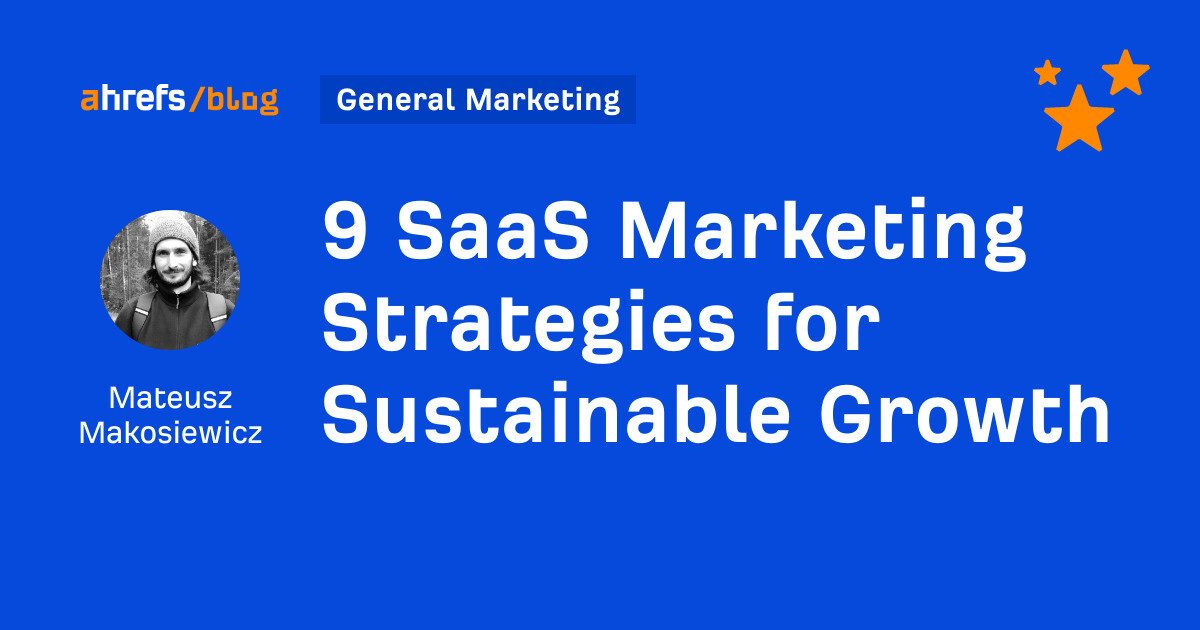
Sustainable growth for a SaaS company is about creating long-term value that is a) profitable and b) able to be maintained over time without compromising the brand’s reputation. In other words, by building growth, you’re building a foundation for more growth as you go.
We’ll talk about nine marketing strategies that are perfect for achieving and maintaining sustainable growth.
Product-market fit (PMF) is when a business has confirmed signals that its product can satisfy an existing demand in a market with high potential.
The usual sign of achieving PMF is when people are willing to buy the product (even if it’s not perfect yet), actively use it, and recommend it to others.
This is a sustainable strategy because it allows you to make sure you’re building something meaningful that will actually get paying users.
PMF automatically makes your messaging more effective. You’re promoting a product people want. And you already know who you’re talking to, so your marketing dollars are better spent.
Conversely, if none of your marketing efforts seem to work, the problem may be the product and not how creative or well funded your campaigns are.
You can find SaaS companies with product-market fit all around. These will be companies that still offer the same kind of products that made them profitable: Slack, Atlassian, Shopify, etc.
How it works
The general idea is to ship a Minimum Viable Product (MVP) and iterate on it based on real user input until you see that people actively use it and recommend it.
There are five steps in the process:
- Formulate the value hypothesis: Why is a customer likely to buy your product?
- Specify the features of your MVP: The right quantity and quality of features needed to verify the value hypothesis.
- Build your MVP: There are many ways to present your product to your audience; you don’t necessarily need to develop a fully functional product.
- Test the MVP with real users: In other words, get feedback.
- Learn from your users and iterate: Some ideas will need more work, while some are probably destined to fail. Gather your data and make the decision.
When you achieve PMF, it will be time to scale your company and marketing efforts.
This strategy doesn’t need an introduction. We’ve all used product trials and free tools. That said, this strategy can be looked at from different angles. What’s important from a marketing perspective are these three benefits:
- Reduced friction – This means there are fewer objections to trying your product.
- Time to experience the value of the product and get hooked – Reading about a product on a landing page is not the same as experiencing it. Your potential customers will likely expect the possibility to put their hands on the product before they buy.
- Direct marketing channel – You can ask users to sign up for a newsletter or send them messages concerning the product.
For instance, HubSpot carves out parts of the platform for free usage (e.g., CRM, CMS). It does this, as it explains, to increase the force of its marketing flywheel. Or in other words, to propel its entire business model.
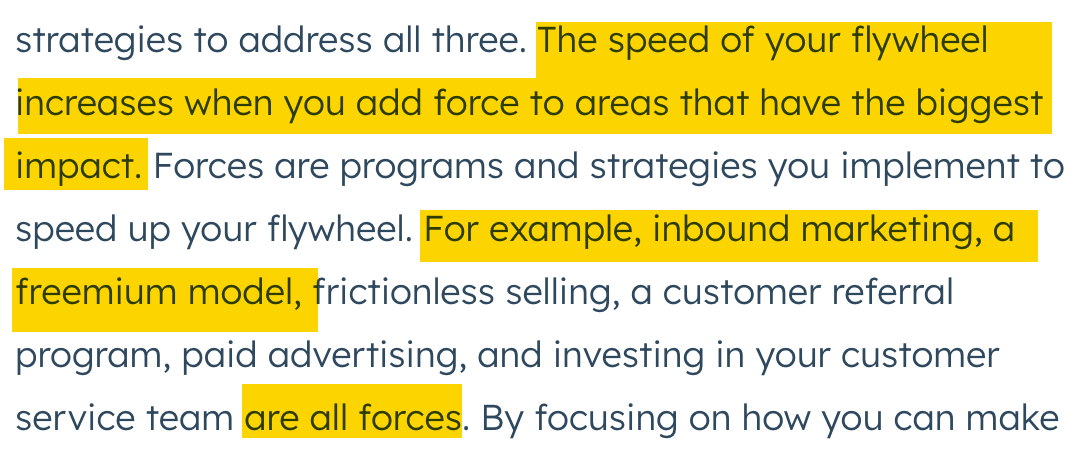
How it works
Start by weighing the pros and cons of free and freemium products.
| Pros | Cons |
|---|---|
| Less friction with getting people to use your product. | Harder to manage expectations. People may expect to get more things for free. |
| Bigger user base. | More server load and possibly more queries to support. |
| Works well with growth loops (more on that later). | Offering something for free may reduce its perceived value. |
| Direct marketing channel to signed-up users (content distribution and upselling). | |
| More feedback. |
Getting users in front of free products is only part of the job. The harder part is getting them to upgrade.
First off, you need to set the right expectations—you won’t convert all of them. For the ones that are “convertible,” here are some tactics you can use:
- Never stop improving customer satisfaction. What your product does and how it does it is absolutely fundamental.
- Educate users about the product. Use blog posts, videos, or quick in-app tips.
- Offer limited access to all newly developed features. For instance, you can allow everyone to use each new feature for five days for free.
- Provide excellent customer service.
- Offer flexible payment options.
When looking for ideas for free products that will generate traffic, try a keyword research tool like Ahrefs’ Keywords Explorer. You can:
- Enter features of your product.
- Go to the Matching terms report.
- Use the Include filter with keyword modifiers pointing to tools, for example: “tool, check, checker, finder, analyzer, builder, free.” Set to “Any word.”
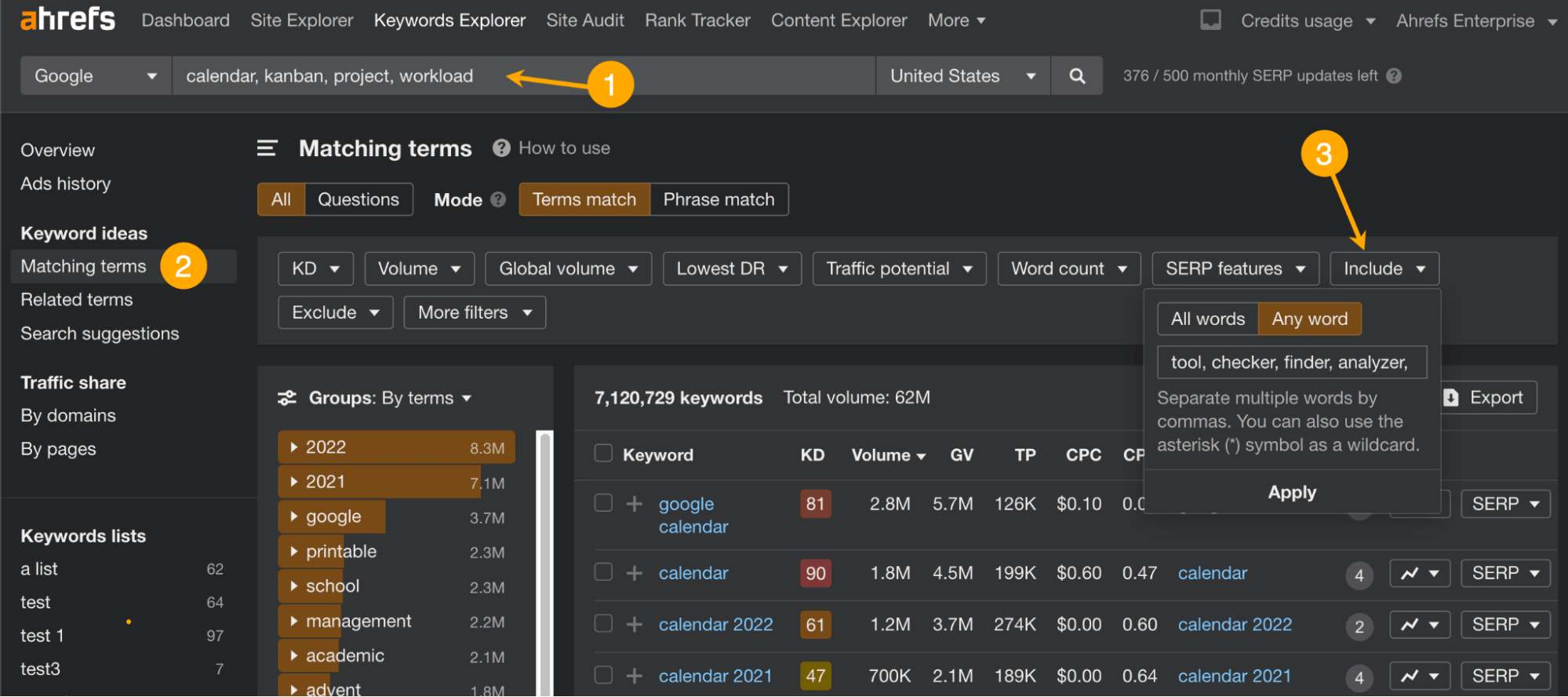
To illustrate, our free website traffic checker tool generates an estimated 33.4K organic visits each month from ranking for keywords like “website traffic checker” or even “website traffic.”

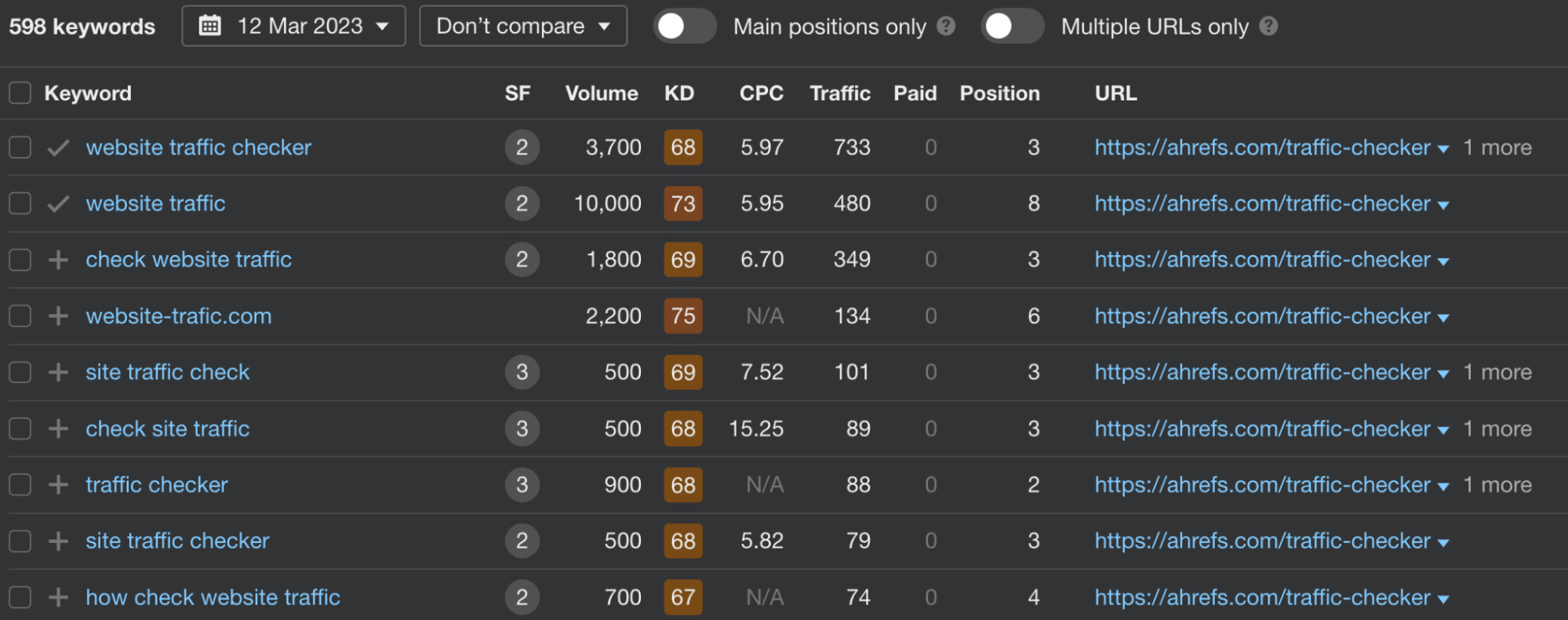
Content marketing is the process of creating and distributing content to attract and retain customers.
If you add search engine optimization to the equation, you get a framework for creating content relevant to your business and the reader. You also get a built-in distribution engine that generates almost free traffic.
SEO is one of the most sustainable marketing strategies because it generates passive traffic that accumulates over time and can generate traffic even years after. To put it differently, SEO results are continuous—and you don’t get that with all marketing strategies.
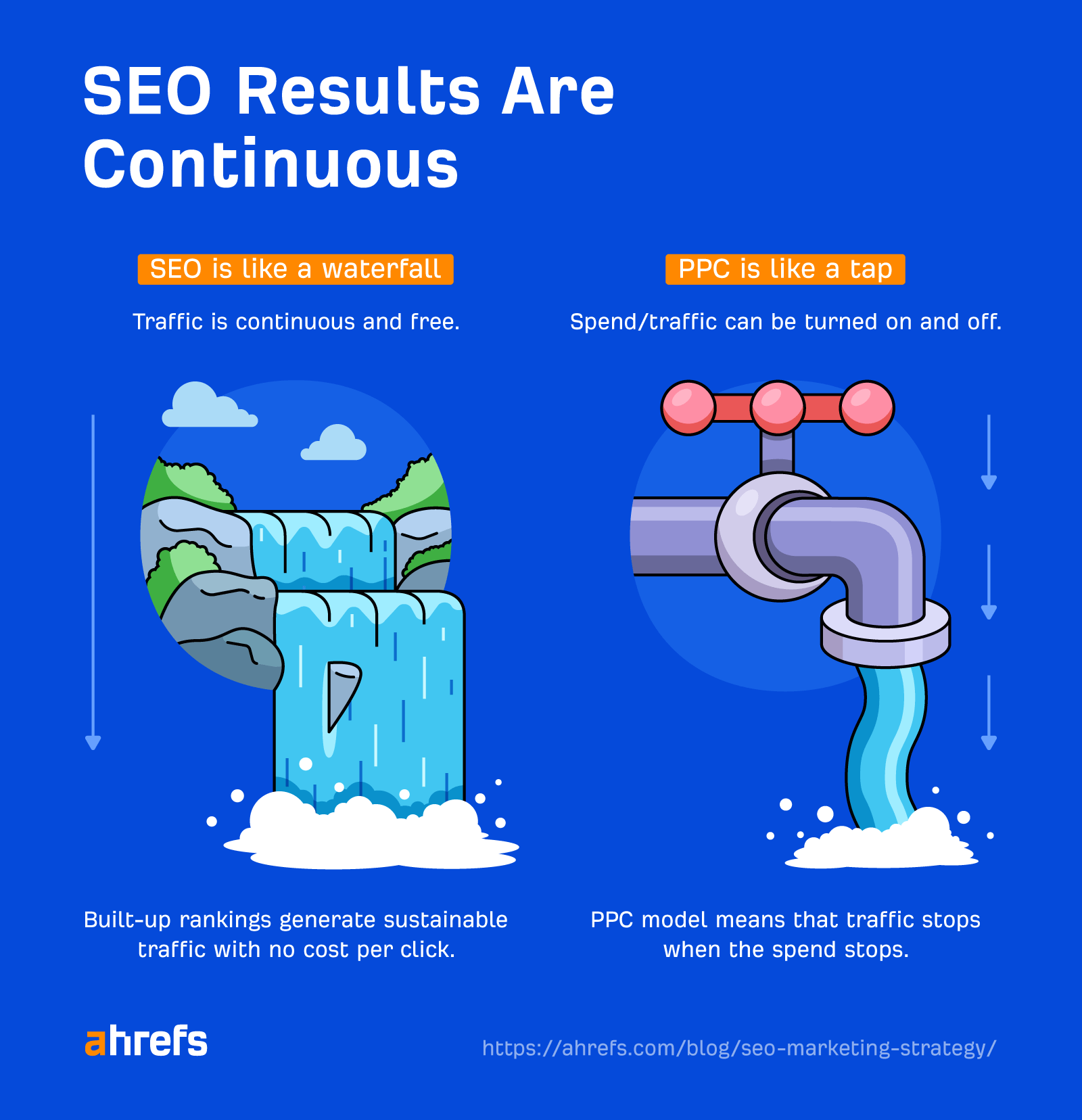
Our blog is an example of such a strategy. It brings an estimated 628K organic visits each month, worth around $860K in ad money, through regular publishing of SEO content.

How it works
SEO is generally worth it if at least one of these is true:
- People are searching for what you sell or do.
- People are searching for solutions to problems your business helps to solve.
- You can give a better solution than the conventional one people are searching for.
In any case, the core of this strategy is to find relevant keywords with traffic potential. The right keywords can connect you with your target audience and create an opportunity to pitch your product. And if you’re not ranking for these keywords, your competitors will.
The process of finding the right keywords for your website is called keyword research. Here’s a quick rundown:
- Go to Keywords Explorer
- Enter industry-related seed keywords, e.g., “seo, digital marketing, keyword, backlink”
- See keyword ideas in the Matching terms report
- Use the filters to refine results if needed (e.g., look only for low-competition keywords or keywords with a certain minimum traffic potential)

Other elements of the SEO process are building a sound technical foundation, creating optimized content, and building links. You can learn how to start with the entire process in our beginner’s guide to SEO.
A user community can help your SaaS product in a number of ways:
- It helps to make the product better through feedback.
- It helps to spread word of mouth about the product even if the community is exclusive.
- It offers added value to the user—they can learn from others in the community and network.
Building a user community is a sustainable strategy because it leverages existing customers and can help facilitate long-term engagement with the product.
A famous example of a community with a price tag on it is Behance, acquired by Adobe for $150M. It generates over 10M search visits each month and allows the parent company to bring the design community very close to its product.
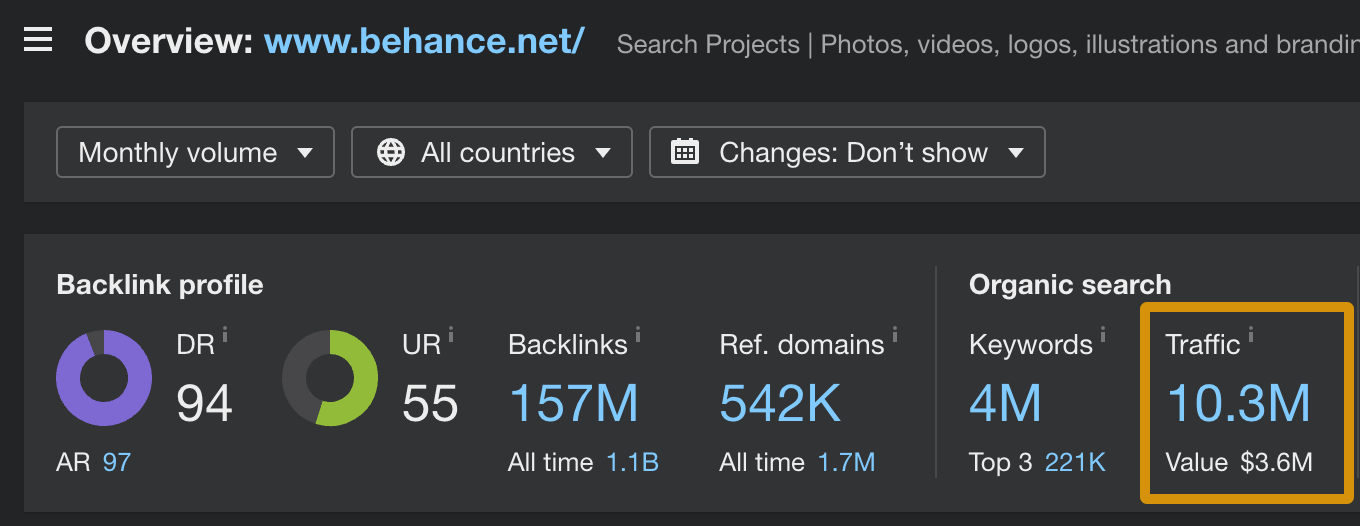

How it works
In a nutshell: create a place where people can meet online, build a constant presence there, and animate the community (feature launches, discussions, polls, etc.).
For example, at Ahrefs, we offer access to our exclusive community, Ahrefs Insider, with every subscription. All we needed to start it was a regular community feature on Facebook. Now it gathers a total of 17K registered users.

Earned media is publicity gained organically from promotional efforts, like press coverage, social media mentions, and search engine rankings.
Earned media is a sustainable form of marketing for these reasons:
- It’s cheaper in the long run compared to advertising (sometimes even free).
- It’s long lasting.
- It earns your brand awareness and credibility.
Here’s an example that checks all three boxes. A while ago, we published a data study showing that 90.63% of content gets no traffic from Google. This article was mentioned by multiple reputable websites, including NY Times, Forbes, and main SEO blogs. All of that coverage gave us free brand exposure and backlinks.
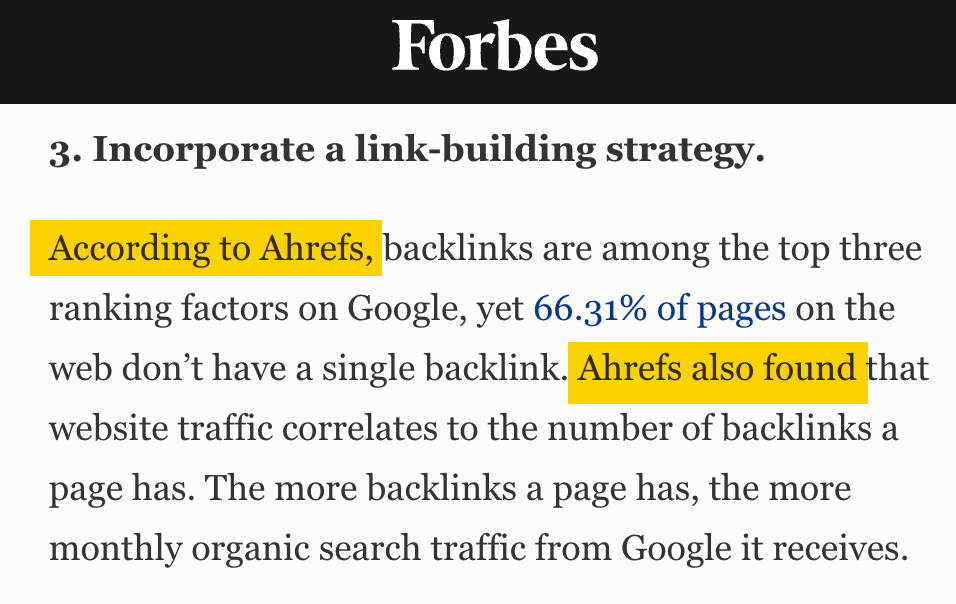
How it works
Earned traffic covers a wide range of marketing tactics, so there’s no silver bullet here. Besides SEO content, which we already touched on, the tactics that are repeatable and will probably have the most impact over time are:
When vetting which site to pitch your product, story, or quote to, you can use Ahrefs’ SEO Toolbar. For instance, say you’re looking for websites that review SaaS products like yours. Just search for your competitors’ reviews in Google and look at the metrics to see which sites can send you stronger links and considerable traffic.

Multi-channel marketing is basically about interacting with your audience using different marketing channels: social media, search, podcasts, email, etc.
Using multi-channel marketing will have the following advantages:
- A broader reach.
- Channels can work to support each other. For example, social media can help you to get links to websites and boost your SEO.
- You create convenience for your audience to interact with the brand.
- There’s less risk, thanks to diversification.
The idea behind this strategy is that your audience is likely scattered across various websites and social media platforms. So even if one marketing channel works exceptionally well, you probably shouldn’t drop all other channels.
How it works
Here are some ideas on how to find the best marketing channels for your business:
- You can see where your competitors promote.
- Do keyword research to estimate organic traffic for relevant keywords (we discussed it in point #3).
- Use audience research tools like SparkToro. Below, you can see a screenshot showing what kind of data about your audience the tool can provide.
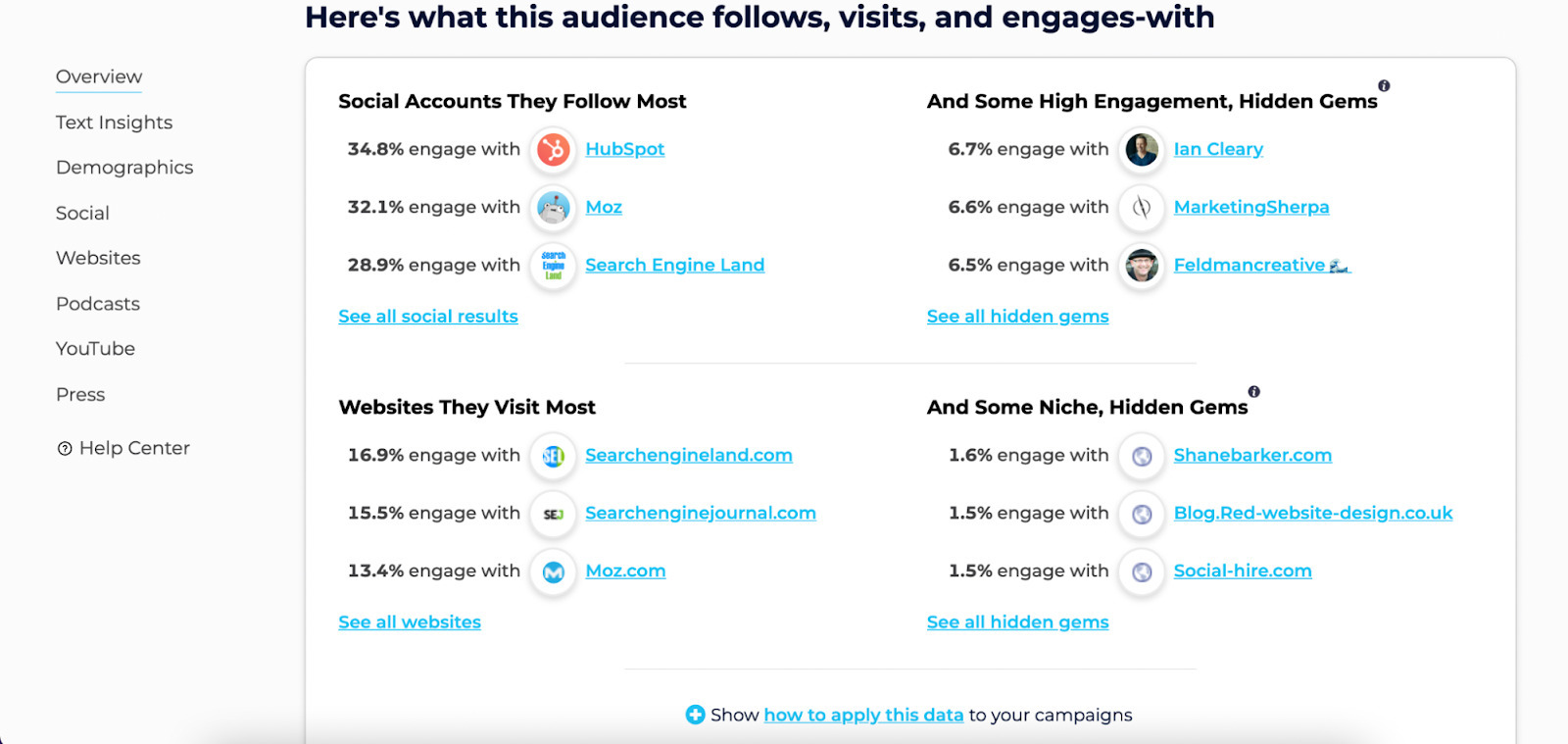
Furthermore, using multiple marketing channels allows you to distribute content more effectively. You can:
- Repurpose content into other formats and platforms.
- Build an audience to distribute content directly (for example, grow your email list).
- Promote the content via ads or sponsored newsletters.
- Syndicate articles to other websites.
Here’s an example. Our thoughts on using ChatGPT for SEO were used in a YouTube video, on our blog, and on social media. While there may be some overlap between these audiences, they are definitely not identical. So by using the multi-channel approach, we were able to get more eyes on our content.
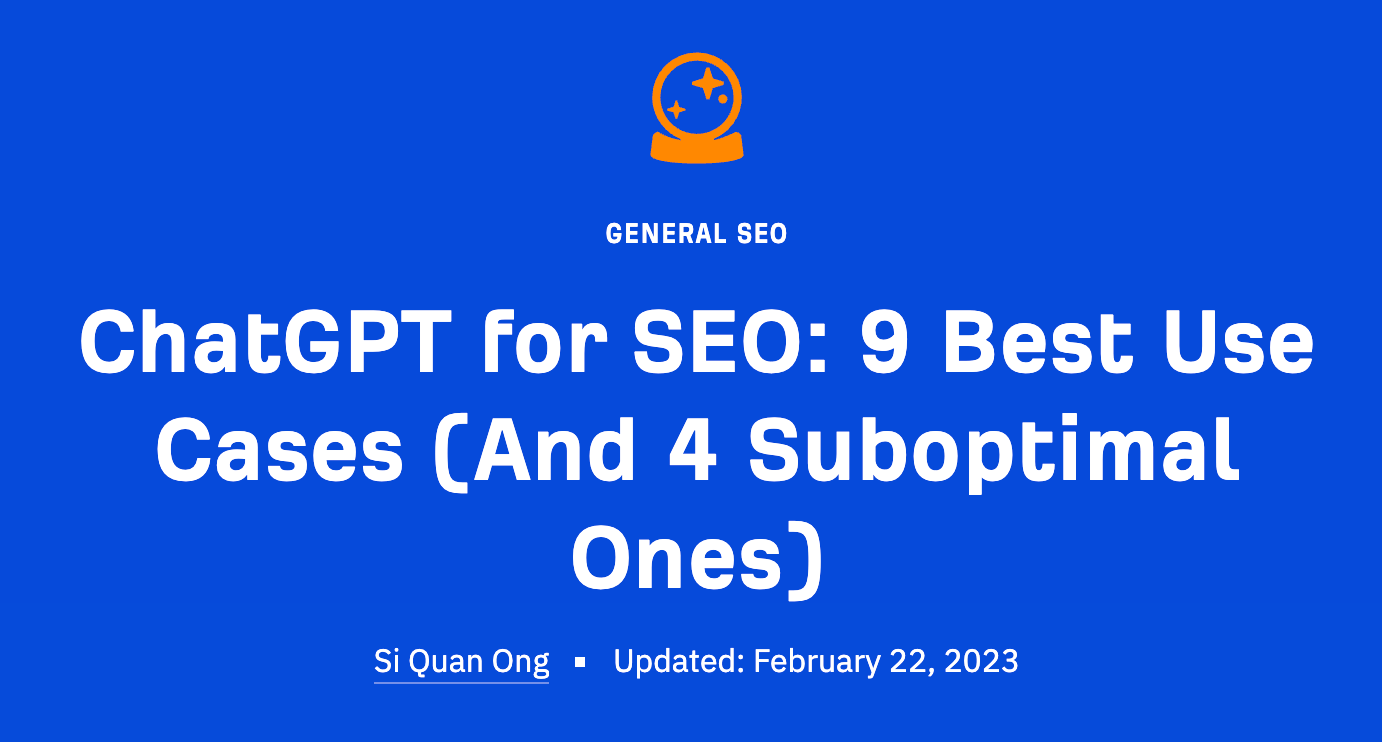
A growth loop is a system where new user input creates an output that drives product demand.
To illustrate, here’s how Notion used a product feature to activate and retain users (courtesy of Foundation).
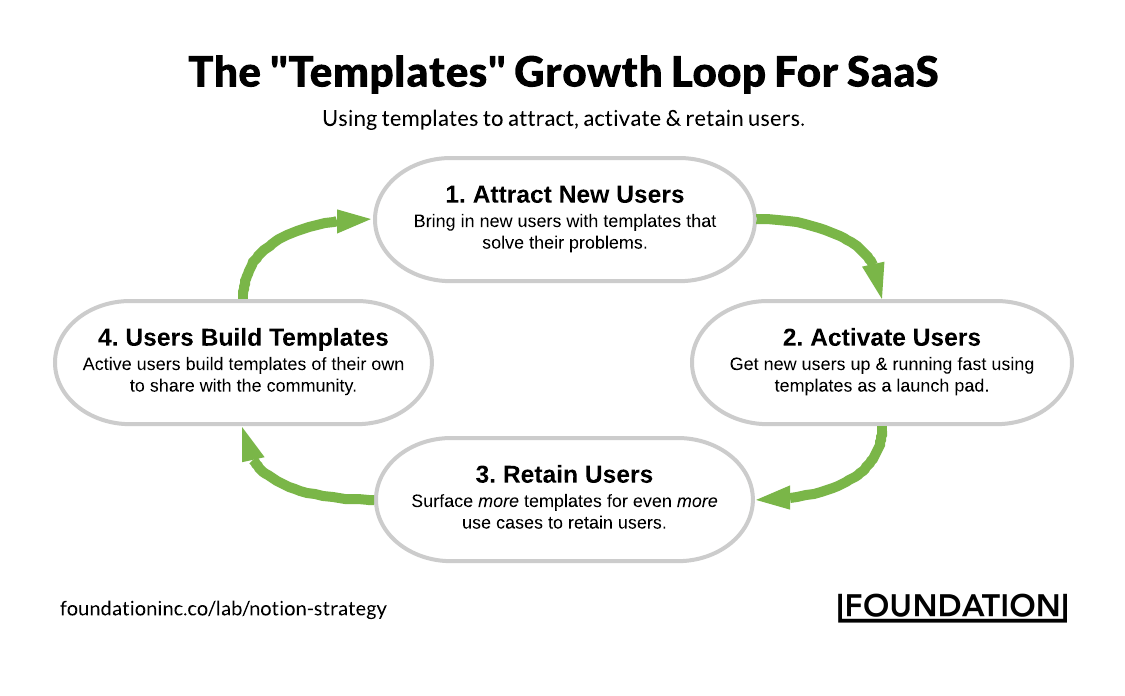
Growth loops are a stellar example of a sustainable marketing strategy because the whole model creates a loop. The more you grow, the more users you get, and so the more you grow.
Furthermore, this strategy gives your marketing budget more “power” since each dollar invested in acquiring a user is also invested in the users generated via the loop.
How it works
The simplest (but super effective) form of a growth loop is making your product outstanding. When your customers love the product and recommend it to others, you start growing on word of mouth—you acquire users you spent nothing to get.
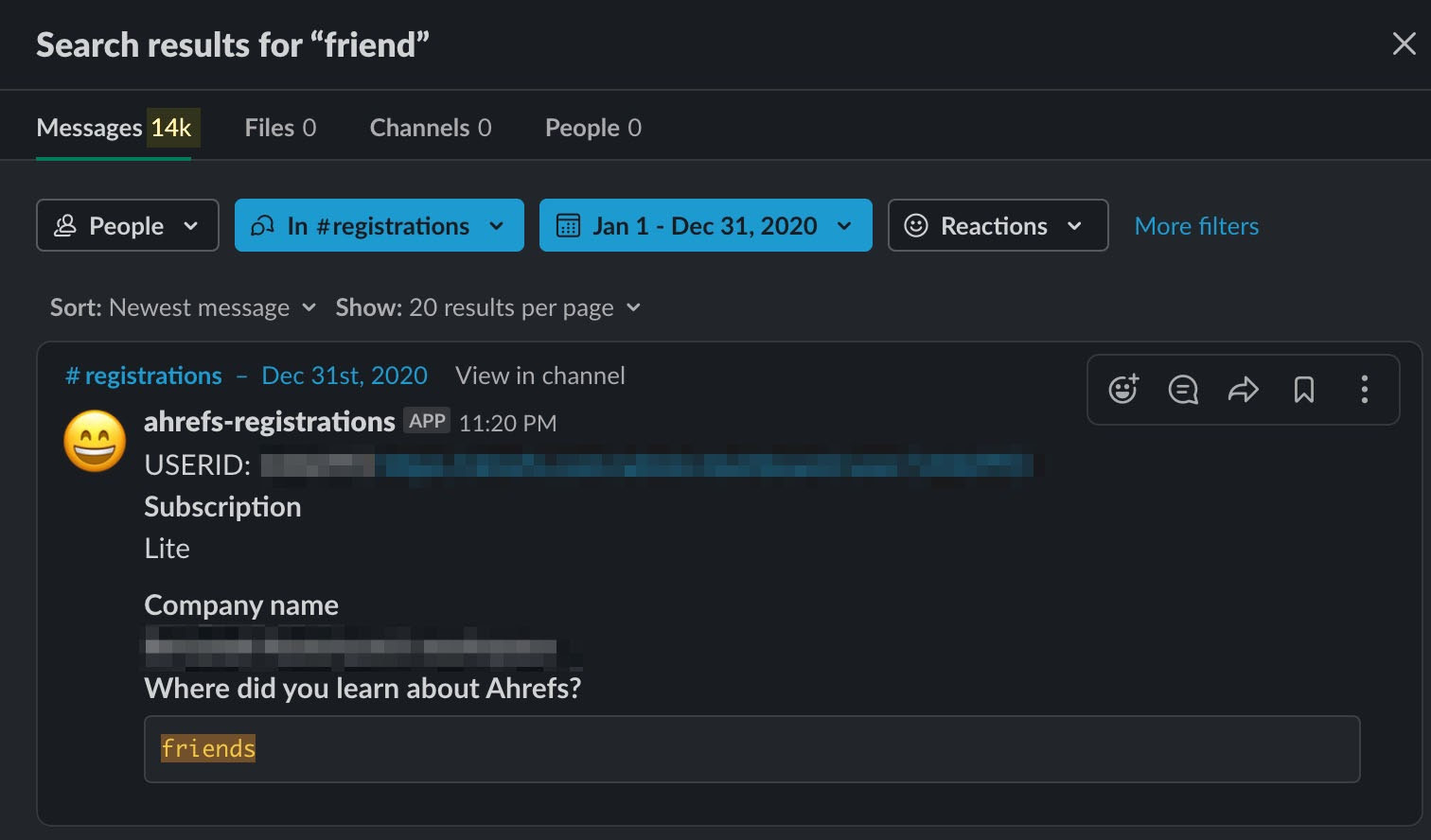
In some types of products, it’s possible to go beyond word of mouth and create a typical growth loop. It all depends on your product and your creativity. Here are a couple of levers you can pull:
- Make it easier for users to share their work publicly like Adobe with Behance
- Devise a referral program like Dropbox
- Create a marketplace for apps like Atlassian or WordPress
- Release an API like OpenAI
- Encourage user-generated content like G2
- Allow for free product usage after creating a free account like Figma or Loom
- Allow users to invite others to their workspaces like Slack or Miro
Revenue expansion is the additional revenue you get from your existing customers through upselling, cross-selling, and add-ons.
It’s a strategy that has proven to work for decades in multiple industries. For instance, this is why when you order a regular pizza, you’re offered to get a bigger one, get a drink with it, or add some extra ingredients.
And here’s an example from the SaaS world. When subscribing to HubSpot, you’re offered to upgrade by increasing the limit of contacts and also to purchase add-ons.
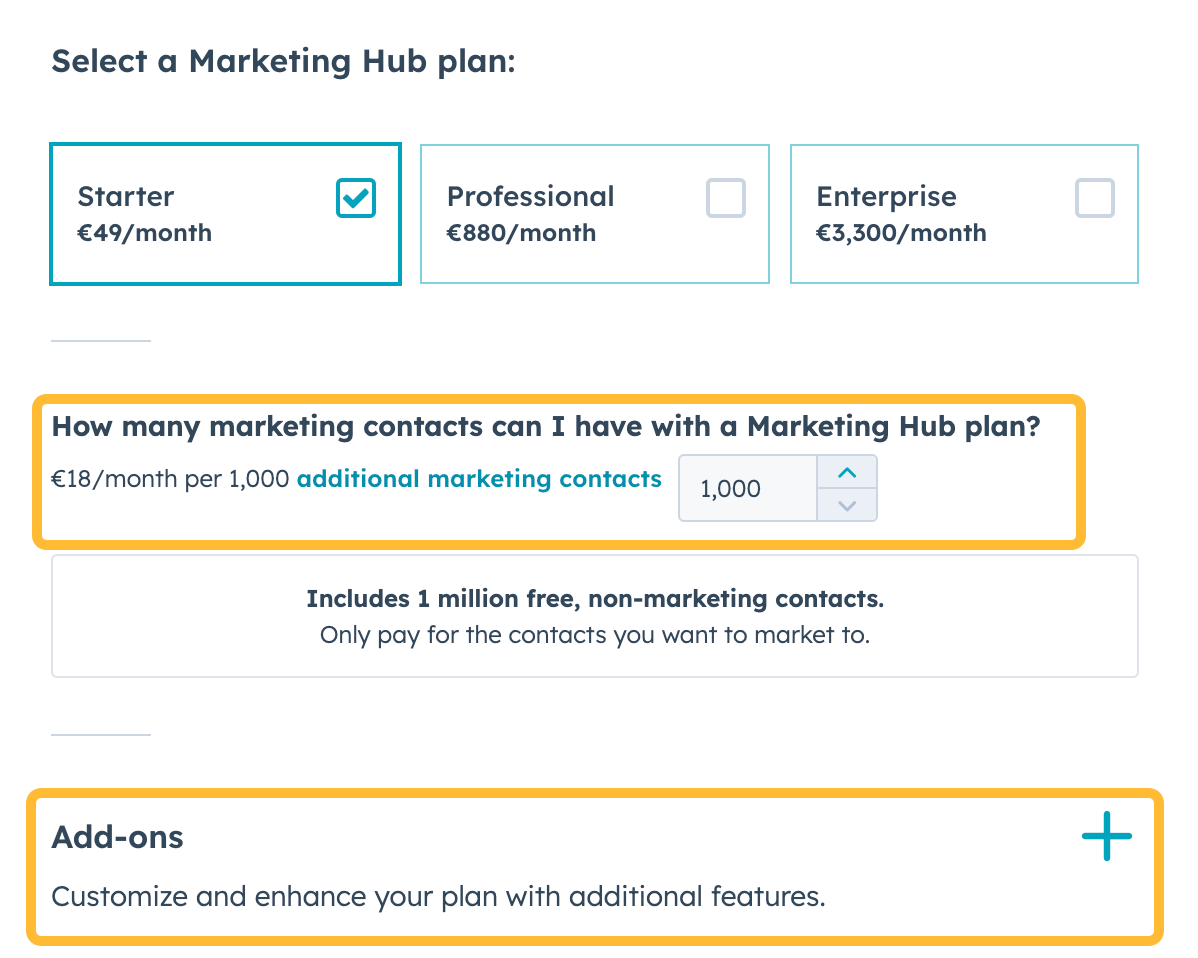
According to a correlation study published by ProfitWell, SaaS subscription-based companies should aim for 20% to 30% expansion revenue in their overall revenue in order to succeed.
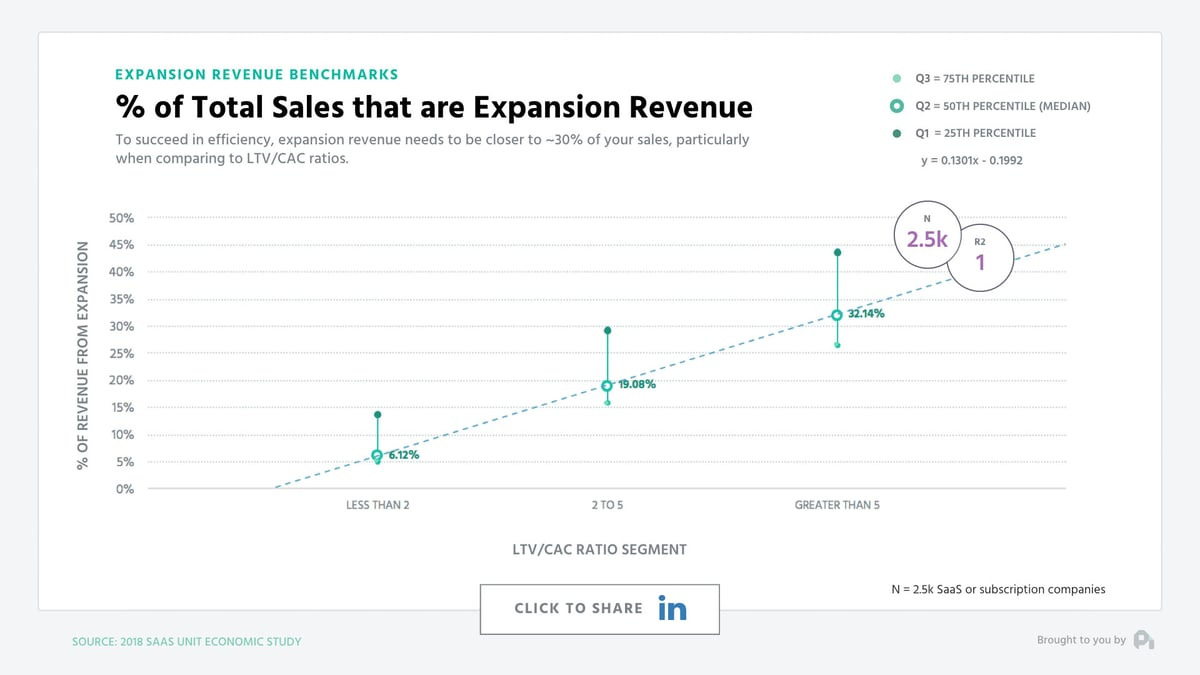
You’ve probably heard that it’s better to retain a customer than to get a new one. That old business adage still holds true. According to this 2016 survey, SaaS companies spend an average of $1.16 to earn $1 on new annual contract value but only $0.27 on upsells and $0.20 on plan expansions.
How it works
If you offer additional value to your satisfied customers, there’s a good chance those customers will be happy to buy more from you. Here are some ideas for creating value for revenue expansion:
- Offer premium features on higher plans
- Offer a per-seat model to cater to both small and large companies
- Add a custom/enterprise tier for the most demanding customers
- Offer priority support
For example, when design tool UXPin developed a way to design with production-ready components, it decided to offer that as a premium version of the product with an almost 80% higher price tag than the UXPin Standard version.
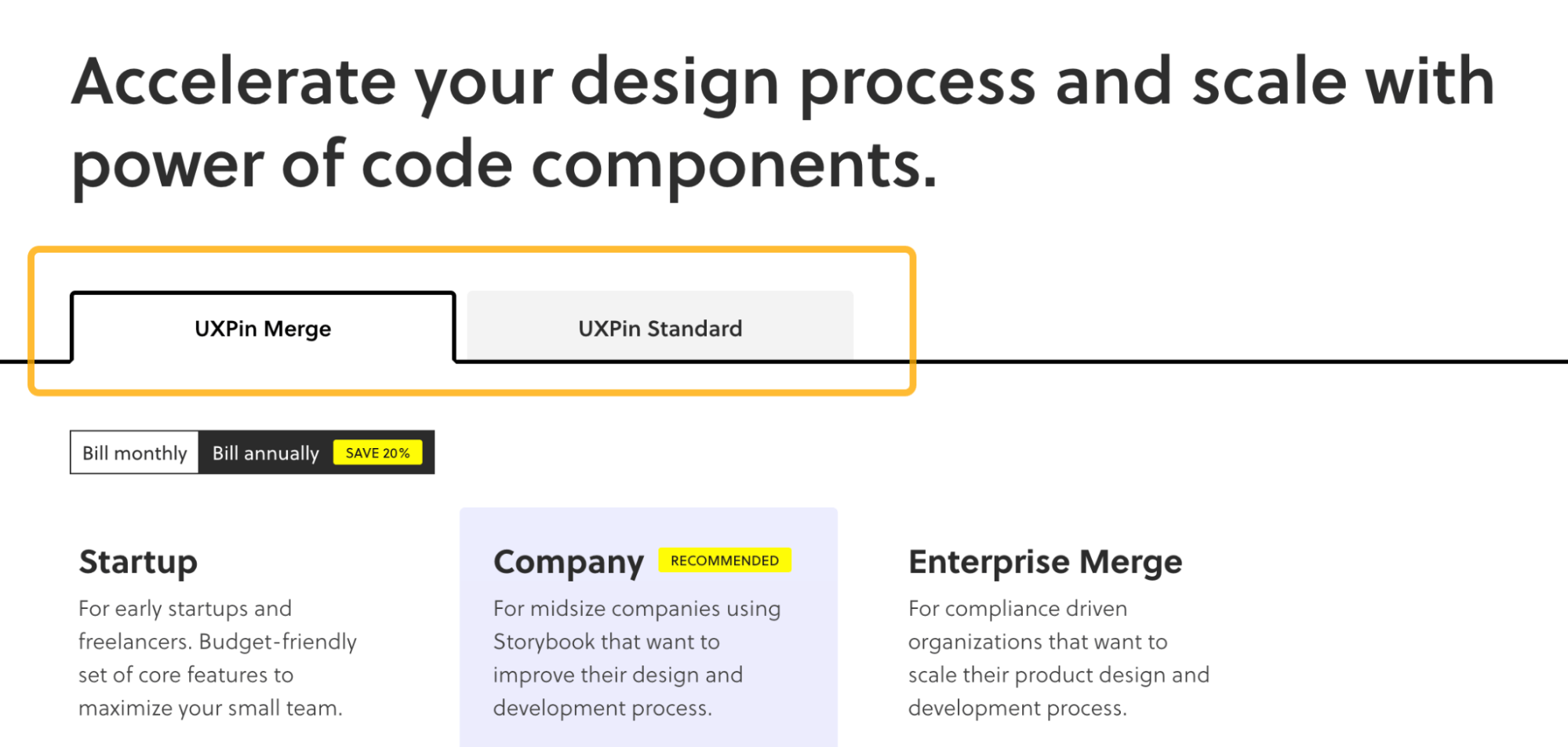
But how to know when and if your customers are willing to expand? Here are some signals:
- Customers often reach their usage limit.
- Customers express interest in additional features or higher tiers.
- Your competitors offer a successful expansion system.
- You’ve got an awesome idea for a premium feature.
Growth marketing is the process of increasing a company’s revenue by applying an experiment-driven and integrated approach to all stages of attracting customers.
To understand this type of marketing better, let’s compare it to traditional marketing and growth hacking (the close variant I don’t recommend).
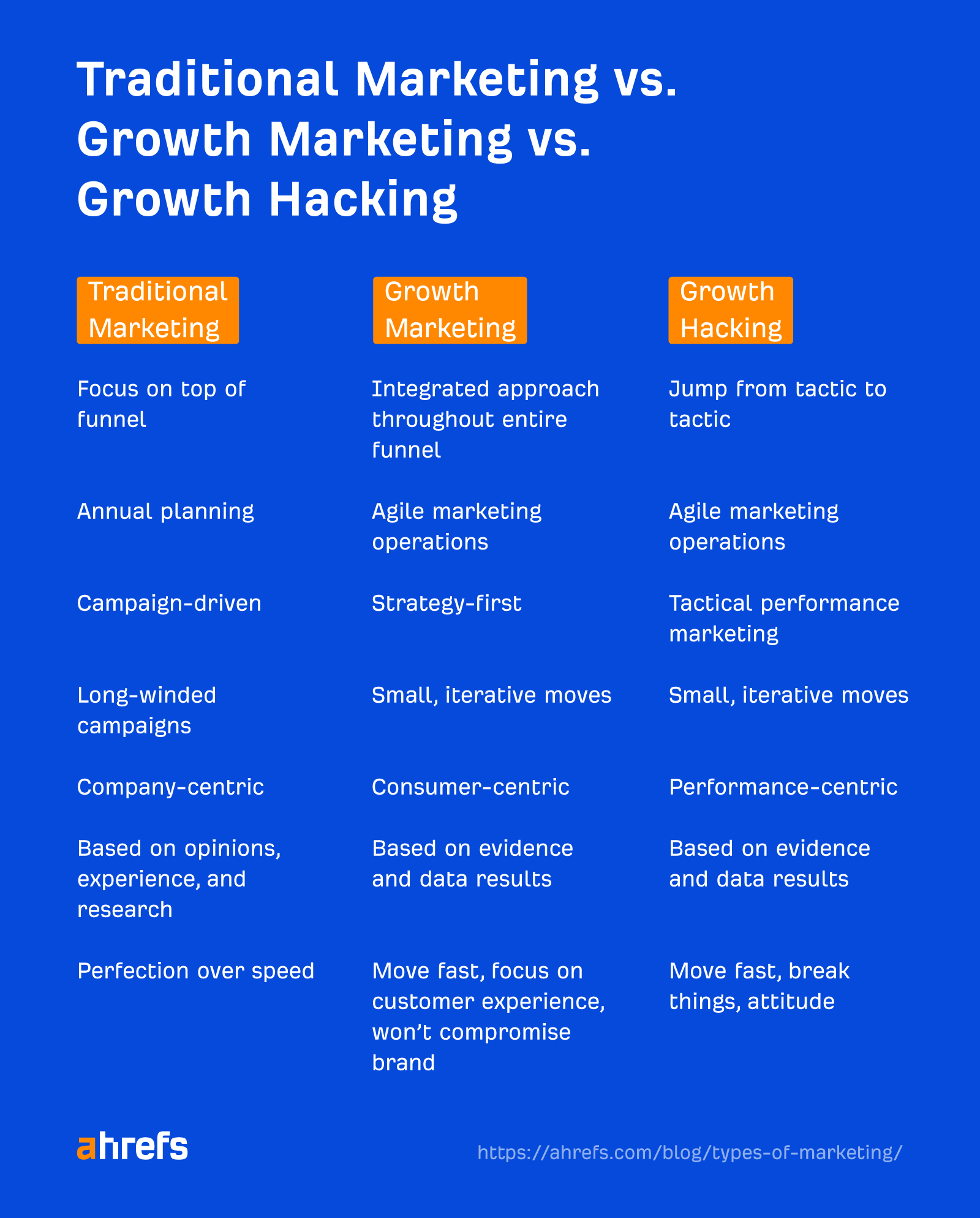
While the obvious solution for more sales is getting more visitors, this is not always the best one. If the product lacks competitive features and if there are obstacles on the path to purchase, money spent on getting more people through the door will always lead to low conversion and high churn. This is where growth marketing comes in.
A great example of growth-oriented thinking is LinkedIn’s Reconnect Flow. It’s a nickname for the early onboarding process where new users were asked questions about their personal experiences and offered connections to existing LinkedIn users based on that. This simple tactic engaged both new and old users.
Another interesting growth tactic LinkedIn used in the early days was encouraging users to import their email contacts (not a common thing back then). It was enough for 7% of new users to import their contacts to increase the overall number of invitations to 30%.
How it works
The idea behind growth marketing is based on the scientific method: propose hypotheses and validate them through experimentation. In marketing, it’s known as the growth hacking cycle.
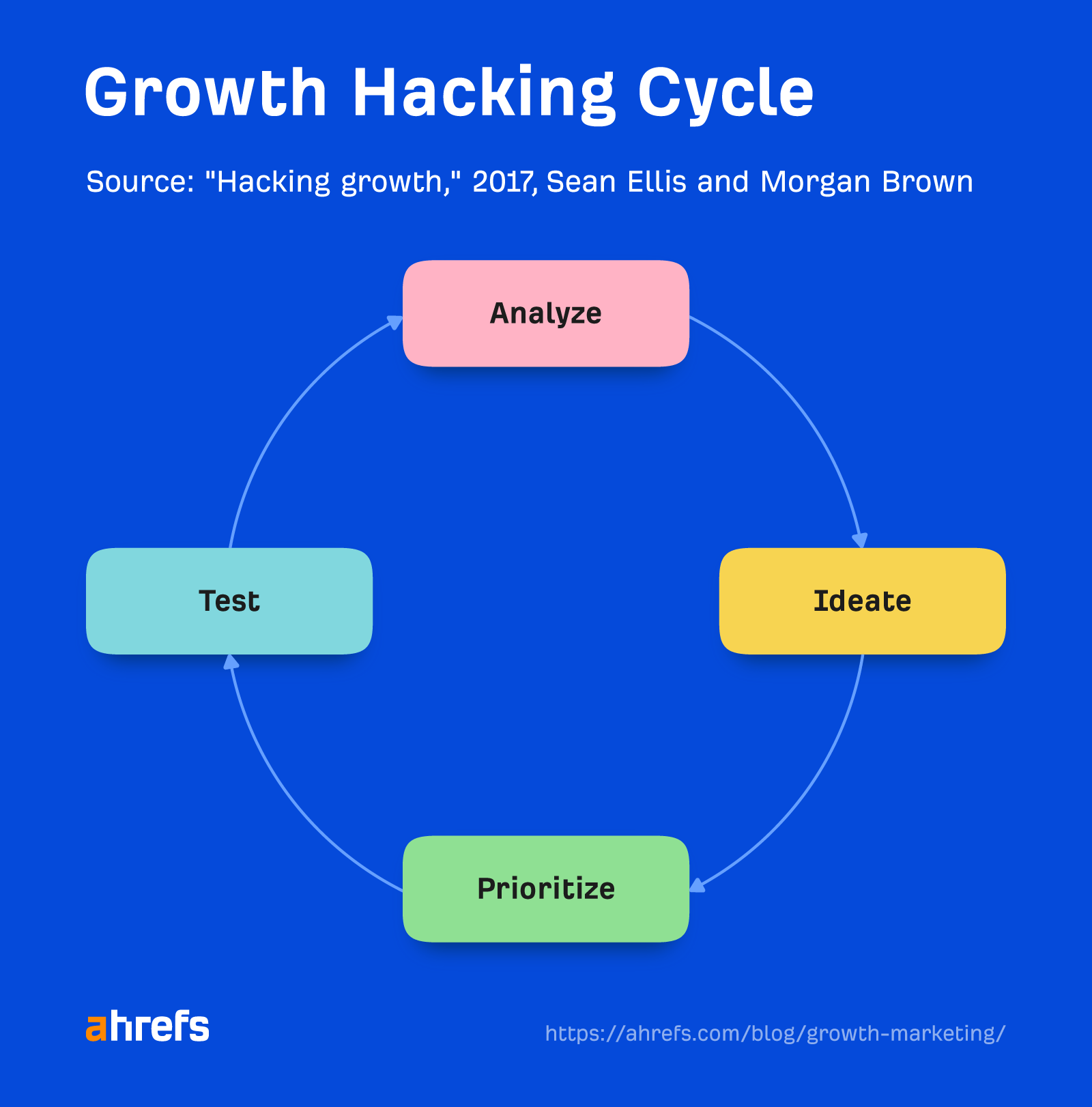
The whole cycle starts by gathering data on the buyer’s journey. Next is generating ideas on how to improve and then testing those ideas (for example through A/B testing).
It may seem like an obvious way to do marketing. But it’s not always that easy: Some tests may be hard to perform, and discipline is required. Also, it’s always faster (but not better) to go with your gut.
An important part of the growth mindset is the ability to analytically break down big problems into smaller pieces. This approach allows for setting more achievable goals.
For instance, a goal to increase sales is too vague because sales rely on many factors and not all of them are controllable. Instead, growth marketers may want to discover what “moves the needle.” Depending on the product, this may be encouraging the user to perform specific actions in the product or gearing pricing and communication toward a new audience.
Final thoughts
Sustainable growth doesn’t rely only on the strategies or tactics you choose. You need to give them time to work out the returns. You also need to experiment with them to see what works best for you.
There’s a great talk by Rand Fishkin on the concept of the flywheel in marketing; how the first push is the hardest, but it builds momentum that makes things easier in the long run. Sustainable growth strategies are just like that. As you build more value into your product and your brand, you gain momentum that acts as a multiplier for every new thing you do.
Got questions or comments? Ping me on Twitter or Mastodon.
SEO
Google Confirms Links Are Not That Important

Google’s Gary Illyes confirmed at a recent search marketing conference that Google needs very few links, adding to the growing body of evidence that publishers need to focus on other factors. Gary tweeted confirmation that he indeed say those words.
Background Of Links For Ranking
Links were discovered in the late 1990’s to be a good signal for search engines to use for validating how authoritative a website is and then Google discovered soon after that anchor text could be used to provide semantic signals about what a webpage was about.
One of the most important research papers was Authoritative Sources in a Hyperlinked Environment by Jon M. Kleinberg, published around 1998 (link to research paper at the end of the article). The main discovery of this research paper is that there is too many web pages and there was no objective way to filter search results for quality in order to rank web pages for a subjective idea of relevance.
The author of the research paper discovered that links could be used as an objective filter for authoritativeness.
Kleinberg wrote:
“To provide effective search methods under these conditions, one needs a way to filter, from among a huge collection of relevant pages, a small set of the most “authoritative” or ‘definitive’ ones.”
This is the most influential research paper on links because it kick-started more research on ways to use links beyond as an authority metric but as a subjective metric for relevance.
Objective is something factual. Subjective is something that’s closer to an opinion. The founders of Google discovered how to use the subjective opinions of the Internet as a relevance metric for what to rank in the search results.
What Larry Page and Sergey Brin discovered and shared in their research paper (The Anatomy of a Large-Scale Hypertextual Web Search Engine – link at end of this article) was that it was possible to harness the power of anchor text to determine the subjective opinion of relevance from actual humans. It was essentially crowdsourcing the opinions of millions of website expressed through the link structure between each webpage.
What Did Gary Illyes Say About Links In 2024?
At a recent search conference in Bulgaria, Google’s Gary Illyes made a comment about how Google doesn’t really need that many links and how Google has made links less important.
Patrick Stox tweeted about what he heard at the search conference:
” ‘We need very few links to rank pages… Over the years we’ve made links less important.’ @methode #serpconf2024″
Google’s Gary Illyes tweeted a confirmation of that statement:
“I shouldn’t have said that… I definitely shouldn’t have said that”
Why Links Matter Less
The initial state of anchor text when Google first used links for ranking purposes was absolutely non-spammy, which is why it was so useful. Hyperlinks were primarily used as a way to send traffic from one website to another website.
But by 2004 or 2005 Google was using statistical analysis to detect manipulated links, then around 2004 “powered-by” links in website footers stopped passing anchor text value, and by 2006 links close to the words “advertising” stopped passing link value, links from directories stopped passing ranking value and by 2012 Google deployed a massive link algorithm called Penguin that destroyed the rankings of likely millions of websites, many of which were using guest posting.
The link signal eventually became so bad that Google decided in 2019 to selectively use nofollow links for ranking purposes. Google’s Gary Illyes confirmed that the change to nofollow was made because of the link signal.
Google Explicitly Confirms That Links Matter Less
In 2023 Google’s Gary Illyes shared at a PubCon Austin that links were not even in the top 3 of ranking factors. Then in March 2024, coinciding with the March 2024 Core Algorithm Update, Google updated their spam policies documentation to downplay the importance of links for ranking purposes.
The documentation previously said:
“Google uses links as an important factor in determining the relevancy of web pages.”
The update to the documentation that mentioned links was updated to remove the word important.
Links are not just listed as just another factor:
“Google uses links as a factor in determining the relevancy of web pages.”
At the beginning of April Google’s John Mueller advised that there are more useful SEO activities to engage on than links.
Mueller explained:
“There are more important things for websites nowadays, and over-focusing on links will often result in you wasting your time doing things that don’t make your website better overall”
Finally, Gary Illyes explicitly said that Google needs very few links to rank webpages and confirmed it.
I shouldn’t have said that… I definitely shouldn’t have said that
— Gary 鯨理/경리 Illyes (so official, trust me) (@methode) April 19, 2024
Why Google Doesn’t Need Links
The reason why Google doesn’t need many links is likely because of the extent of AI and natural language undertanding that Google uses in their algorithms. Google must be highly confident in its algorithm to be able to explicitly say that they don’t need it.
Way back when Google implemented the nofollow into the algorithm there were many link builders who sold comment spam links who continued to lie that comment spam still worked. As someone who started link building at the very beginning of modern SEO (I was the moderator of the link building forum at the #1 SEO forum of that time), I can say with confidence that links have stopped playing much of a role in rankings beginning several years ago, which is why I stopped about five or six years ago.
Read the research papers
Authoritative Sources in a Hyperlinked Environment – Jon M. Kleinberg (PDF)
The Anatomy of a Large-Scale Hypertextual Web Search Engine
Featured Image by Shutterstock/RYO Alexandre
SEO
How to Become an SEO Lead (10 Tips That Advanced My Career)

A few years ago, I was an SEO Lead managing enterprise clients’ SEO campaigns. It’s a senior role and takes a lot of work to get there. So how can you do it, too?
In this article, I’ll share ten tips to help you climb the next rung in the SEO career ladder.
Helping new hires in the SEO team is important if you want to become an SEO Lead. It gives you the experience to develop your leadership skills, and you can also share your knowledge and help others learn and grow.
It demonstrates you can explain things well, provide helpful feedback, and improve the team’s standard of work. It shows you care about the team’s success, which is essential for leaders. Bosses look for someone who can do their work well and help everyone improve.
Here are some practical examples of things I did early in my career to help mentor junior members of the team that you can try as well:
- Hold “lunch and learn” sessions on topics related to SEO and share case studies of work you have done
- Create process documents for the junior members of the team to show them how to complete specific tasks related to your work
- Compile lists of your favorite tools and resources for junior members of the team
- Create onboarding documents for interns joining the company
Wouldn’t it be great if you could look at every single SEO Lead’s resume? Well, you already can. You can infer ~70% of any SEO’s resume by spying on their LinkedIn and social media channels.
Type “SEO Lead” into LinkedIn and see what you get.
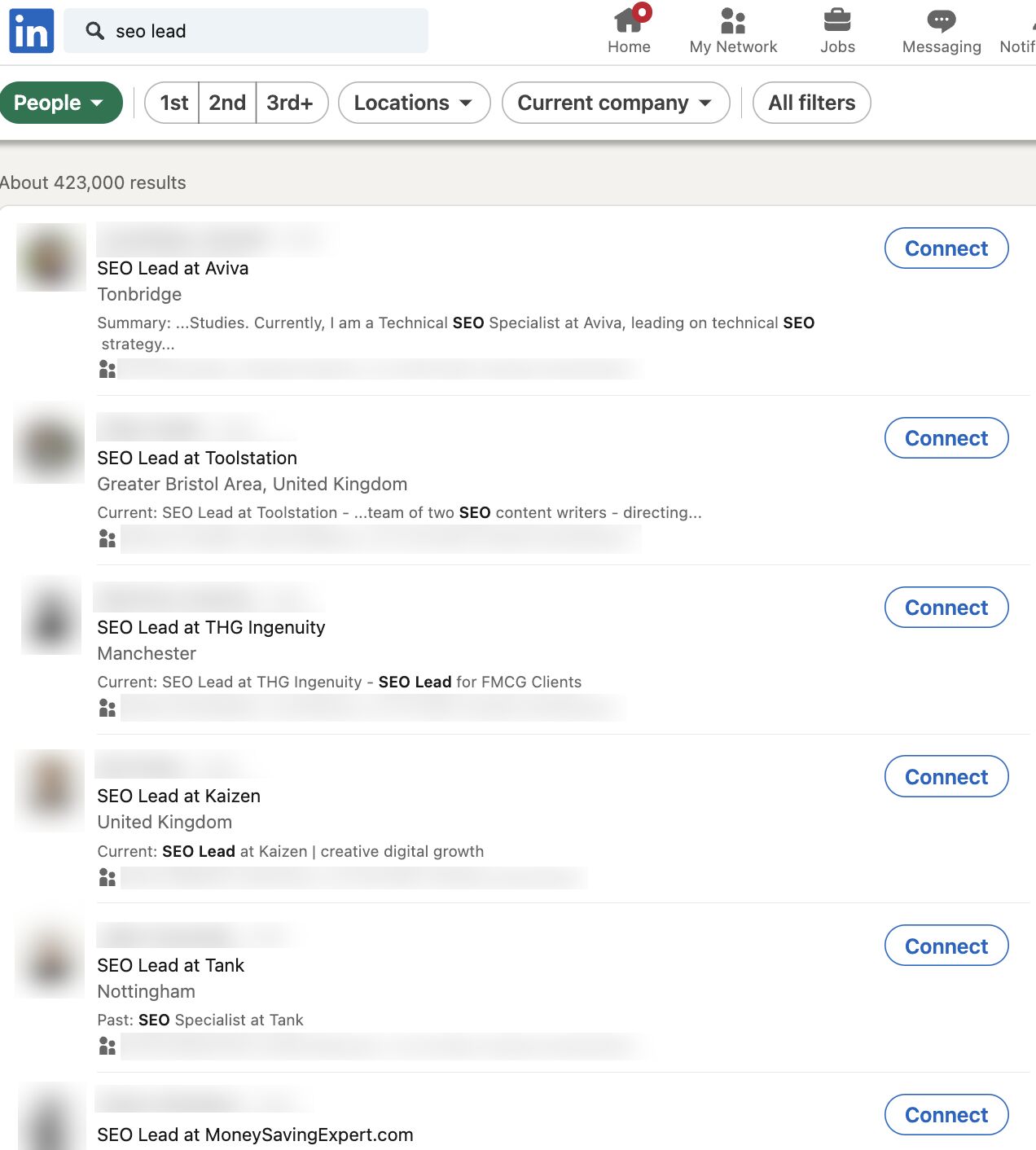
Tip
Look for common career patterns of the SEOs you admire in the industry.
I used this method to understand how my favorite SEOs and people at my company navigated their way from a junior role to a senior role.
For example, when the Head of SEO at the time Kirsty Hulse, joined my team, I added her on LinkedIn and realized that if I wanted to follow in her footsteps, I’d need to start by getting the role of SEO Manager to stand any possible chance of leading SEO campaigns like she was.
The progression in my company was from SEO Executive to Senior SEO Executive (Junior roles in London, UK), but as an outsider coming into the company, Kirsty showed me that it was possible to jump straight to SEO Manager given the right circumstances.
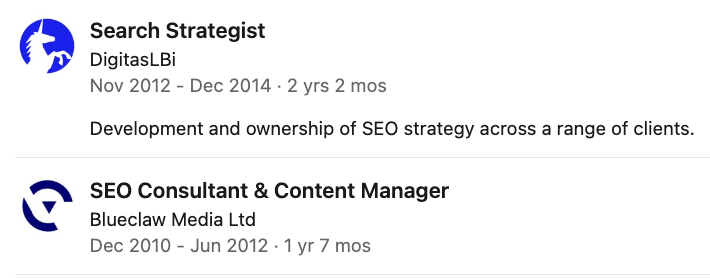

Using Kirsty’s and other SEOs’ profiles, I decided that the next step in my career needed to be SEO Manager, and at some point, I needed to get some experience with a bigger media agency so I could work my way up to leading an SEO campaign with bigger brands.
Sadly, you can’t just rock up to a monthly meeting and start leading a big brand SEO campaign. You’ll need to prove yourself to your line manager first. So how can you do this?
Here’s what I’d suggest you do:
- Create a strong track record with smaller companies.
- Obsessively share your wins with your company, so that senior management will already know you can deliver.
- At your performance review, tell your line manager that you want to work on bigger campaigns and take on more responsibility.
If there’s no hope of working with a big brand at your current job, you might need to consider looking for a new job where there is a recognizable brand. This was what I realized I needed to do if I wanted to get more experience.
Tip
Get recruiters on LinkedIn to give you the inside scoop on which brands or agencies are hiring. Ask them if you have any skill gaps on your resume that could prevent you from getting a job with these companies.
Being critical of your skill gaps can be hard to do. I found the best way to identify them early in my career was to ask other people—specifically recruiters. They had knowledge of the industry and were usually fairly honest as to what I needed to improve.
From this, I realized I lacked experience working with other teams—like PR, social, and development teams. As a junior SEO, your mind is focused 99% on doing SEO, but when you become more senior, your integration with other teams is important to your success.
For this reason, I’d suggest that aspiring SEO Leads should have a good working knowledge of how other teams outside of SEO operate. If you take the time to do this, it will pay dividends later in your career:
- If there are other teams in your company, ask if you can do some onboarding training with them.
- Get to know other team leads within your company and learn how they work.
- Take training courses to learn the fundamentals of other disciplines that complement SEO, such as Python, SQL, or content creation.
Sometimes, employers use skill gaps to pay you less, so it’s crucial to get the skills you need early on…


Examples of other skill gaps I’ve noticed include:
Tip
If you think you have a lot of skill gaps, then you can brush up your skills with our SEO academy. Once you’ve completed that, you can fast-track your knowledge by taking a course like Tom Critchlow’s SEO MBA, or you can try to develop these skills through your job.


As a junior in any company, it can be hard to get your voice heard amongst the senior crowd. Ten years ago, I shared my wins with the team in a weekly group email in the office.
Here’s what you should be sharing:
- Praise from 3rd parties, e.g. “the client said they are impressed with the work this month.”
- Successful performance insights, e.g “following our SEO change, the client has seen X% more conversions this month.”
- Examples of the work you led, e.g. if your leadership and decision-making led to good results, then you need to share it.
At Ahrefs I keep a “wins” document. It’s just a simple spreadsheet that lists feedback on the blog posts I’ve written, the links I’ve earned and what newsletters my post was included in. It’s useful to have a document like this so you have a record of your achievements.
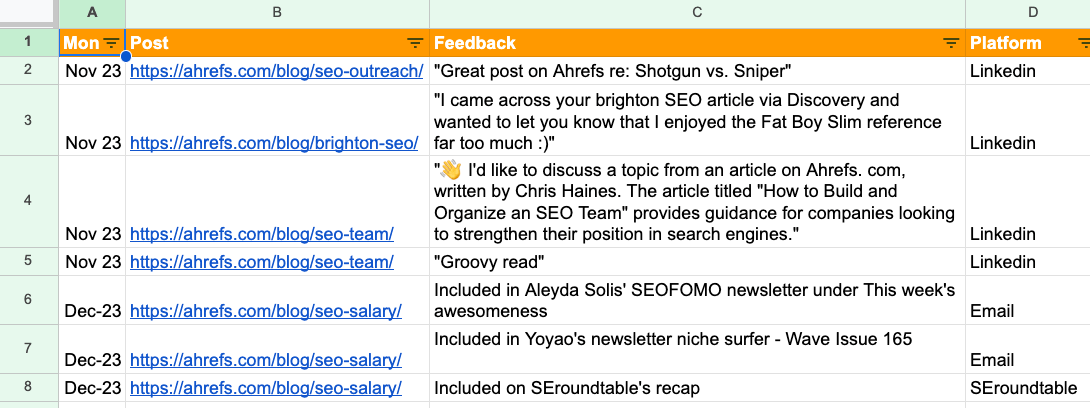

Sidenote.
Junior SEOs sometimes talk about the things “we” achieved as a team rather than what they achieved at the interview stage. If you want the SEO Lead role, remember to talk about what you achieved. While there’s no “I” in team, you also need to advocate for yourself.
One of my first big wins as an SEO was getting a link from an outreach campaign on Buzzfeed. When I went to Brighton SEO later that year and saw Matthew Howells-Barby sharing how he got a Buzzfeed link, I realized that this was not something everyone had done.
So when I did manage to become an SEO Lead, and my team won a prize in Publicis Groupe for our SEO performance, I made sure everyone knew about the work we did. I even wrote a case study on the work for Publicis Groupe’s intranet.


I’ve worked with some incredibly talented people, many of whom have helped me in my career.
I owe my big break to Tim Cripps, Laura Scott, and Kevin Mclaren. Without their support and encouragement, I wouldn’t be where I am today. Even before that, David Schulhof, Jodie Wheeler, and Carl Brooks let me mastermind some bonkers content campaigns that were lucky enough to succeed:


I wasn’t even an SEO Lead at that point, but they gave me the reins and trusted me.
So, how can you find your tribe?
- Speak to recruiters – they might hold the ticket to your next dream job. I spoke to many recruiters early in my career, but only two recruiters delivered for me—they were Natasha Woodford, and Amalia Gouta. Natasha helped me get a job that filled my skill gap, and Amalia helped me get my first SEO Lead role.
- Go to events and SEO conferences, and talk to speakers to build connections outside of your company.
- Use LinkedIn and other social media to interact with other companies or individuals that resonate with you.
Many senior SEO professionals spend most of their online lives on X and LinkedIn. If you’re not using them, you’re missing out on juicy opportunities.


Sharing your expertise on these platforms is one of the easiest ways to increase your chances of getting a senior SEO role. Because, believe it or not, sometimes a job offer can be just a DM away.
Here’s some specific ideas of what you can share:
- Share your thoughts on a trending topic – like the latest Google algorithm update.
- Share what you learned during the course of a campaign.
- Ask the community for their thoughts on a certain topic.
I’ve recently started posting on LinkedIn and am impressed by the reach you can get by posting infrequently on these topics.
Here’s an example of one of my posts where I asked the community for help researching an article I was writing:
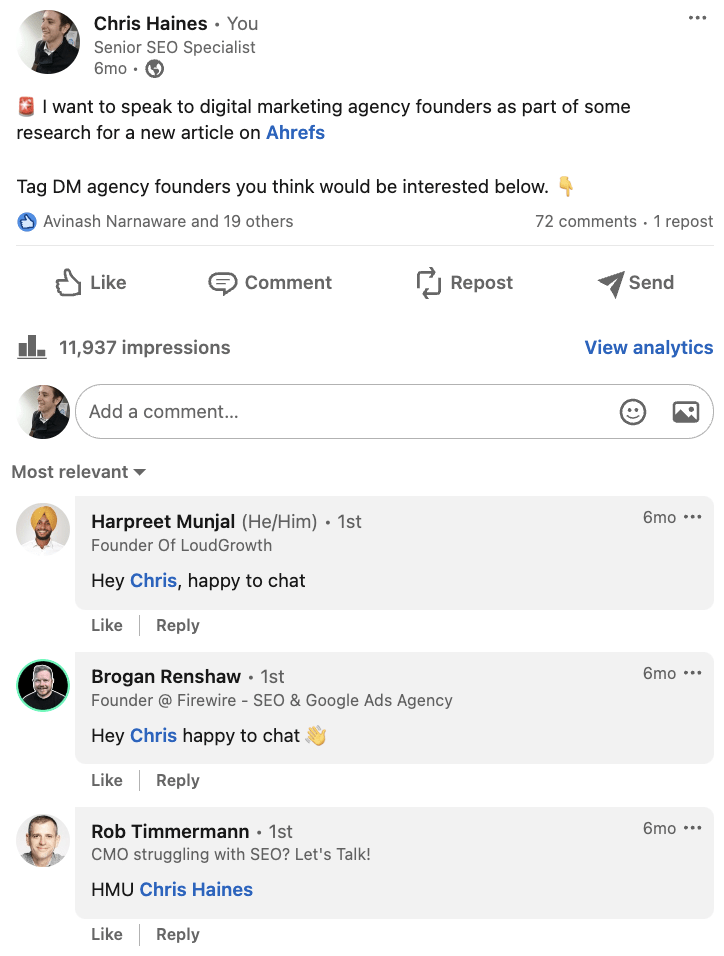

And here is the content performance across the last year from posting these updates.
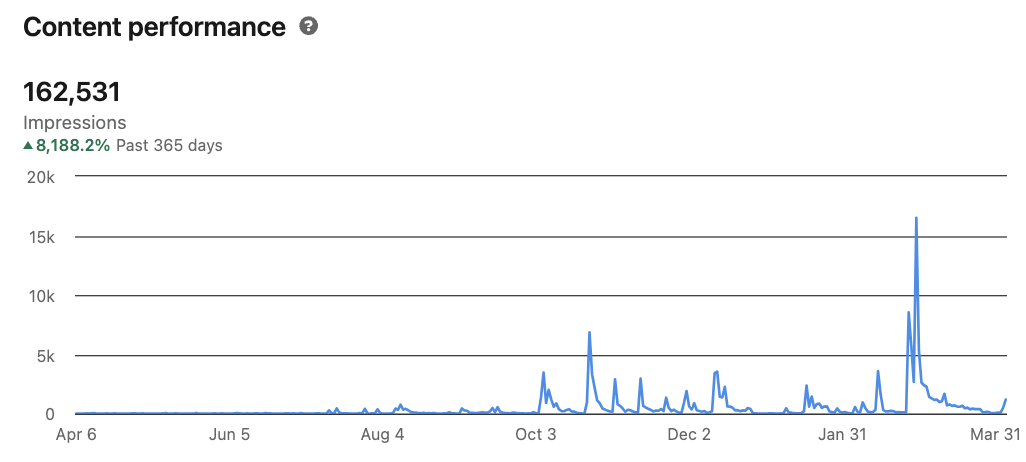

I’m clearly not a LinkedIn expert—far from it! But as you can see, with just a few months of posting, you can start to make these platforms work for you.
Godard Abel, co-founder of G2, talked on a podcast about conscious leadership. This struck a chord with me recently as I realized that I had practiced some of the principles of conscious leadership—unconsciously.
You can start practicing conscious leadership by asking yourself if your actions are above or below the line. Here are a few examples of above and below-the-line thinking:
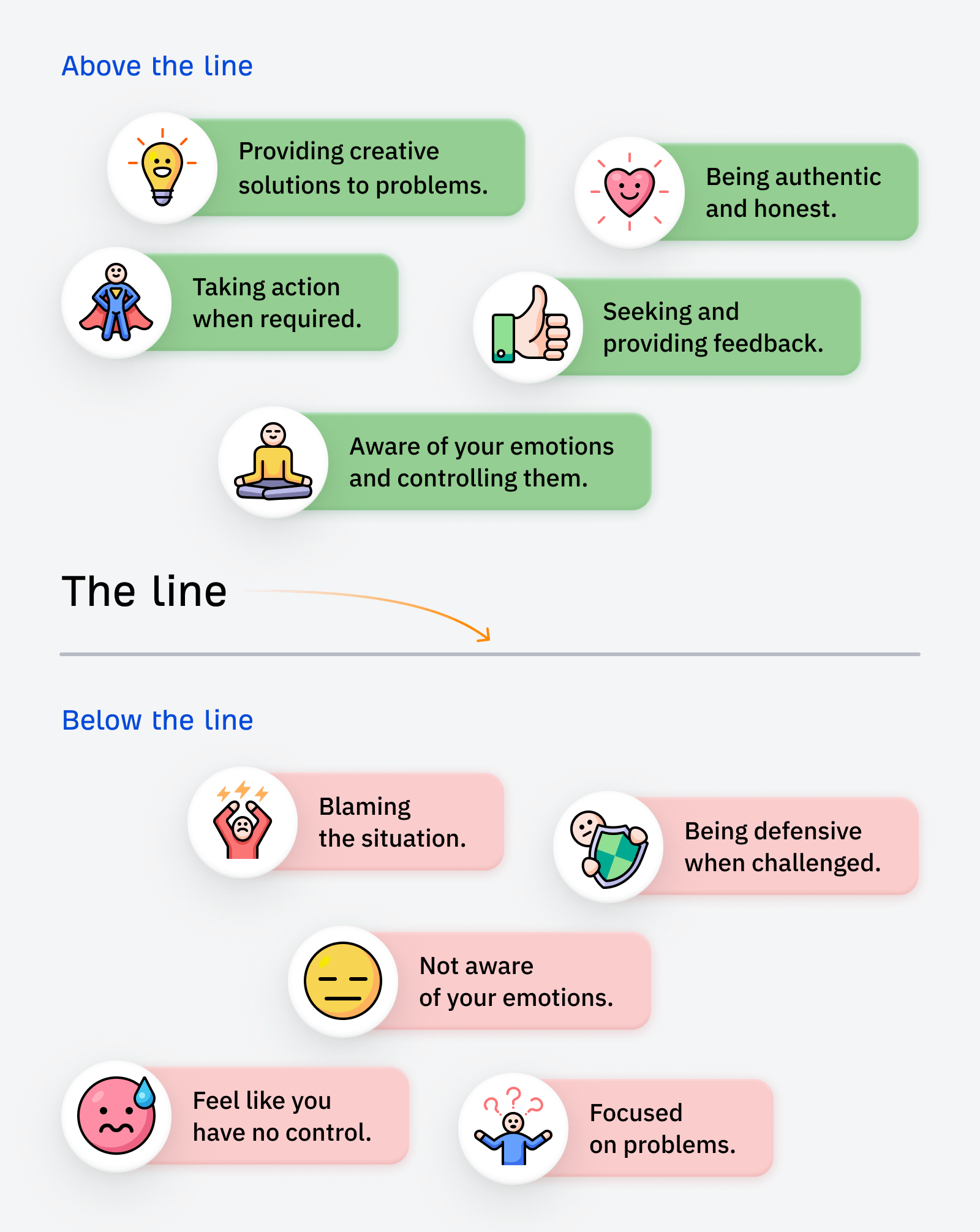

If you want a senior SEO role, I’d suggest shifting your mindset to above-the-line thinking.
In the world of SEO, it’s easy to blame all your search engine woes on Google. We’ve all been there. But a lot of the time, simple changes to your website can make a huge difference—it just takes a bit of effort to find them and make the changes.
SEO is not an exact science. Some stakeholders naturally get nervous if they sense you aren’t sure about what you’re saying. If you don’t get their support early on then you fall at the first hurdle.


To become more persuasive, try incorporating Aristotle’s three persuasive techniques into your conversations.
- Pathos: use logical reasoning, facts, and data to present water-tight arguments.
- Ethos: establish your credibility and ethics through results.
- Logos: make your reports tell a story.
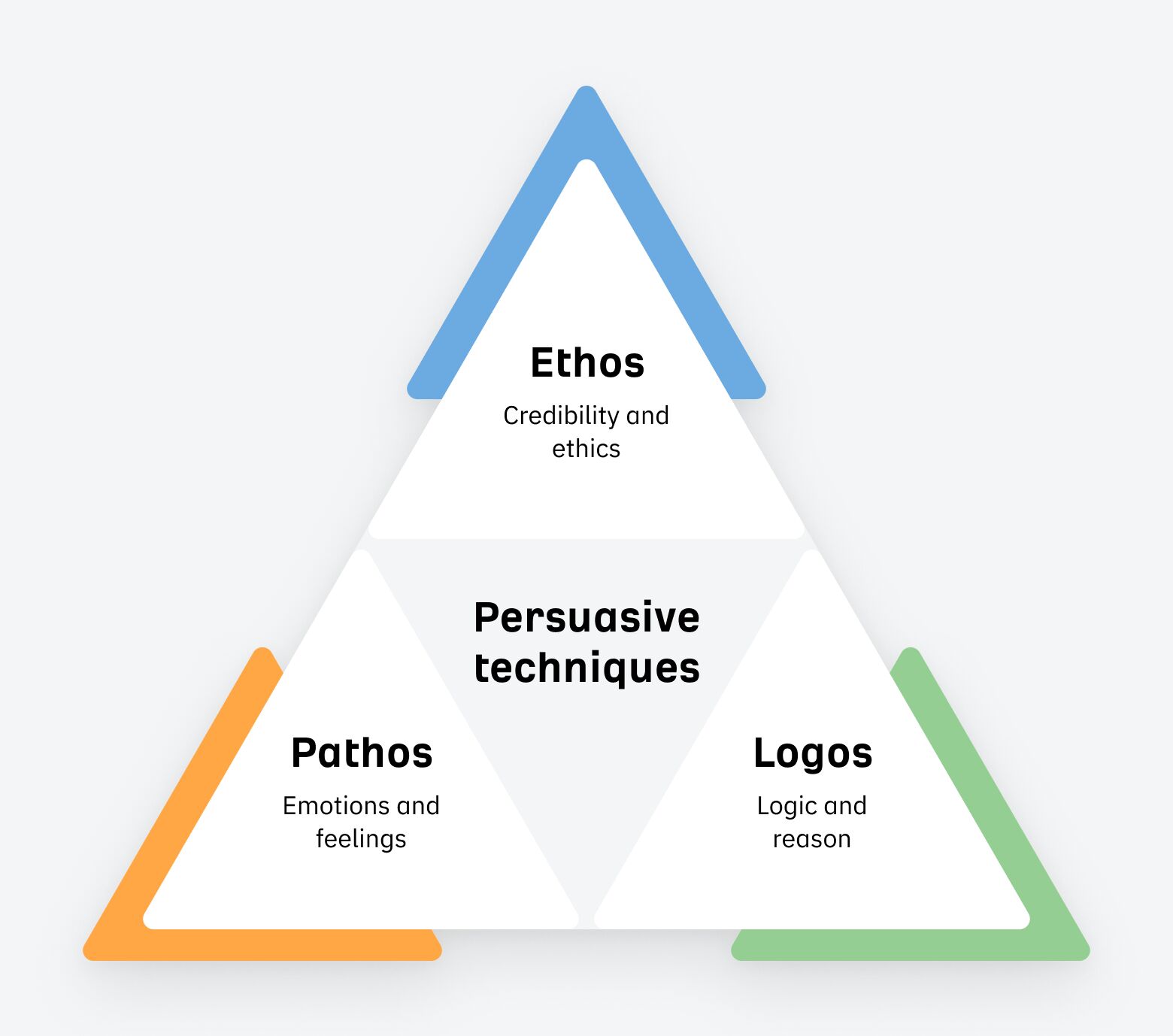

Then sprinkle in language that has a high level of modality:


Some people will be able to do this naturally without even realizing it, but for others, it can be an uphill struggle. It wasn’t easy for me, and I had to learn to adapt the way I talked to stakeholders early on.
The strongest way I found was to appeal to emotions and back up with data from a platform like Ahrefs. Highlight what competitors have done in terms of SEO and the results they’ve earned from doing it.
Sidenote.
You don’t have to follow this tip to the letter, but being aware of these concepts means you’ll start to present more confident and persuasive arguments for justifying your SEO strategies.
When I started in SEO, I had zero connections. Getting a job felt like an impossible challenge.
Once I’d got my first SEO Lead job, it felt stupidly easy to get another one—just through connections I’d made along the way in my SEO journey.
I once got stuck on a delayed train with a senior member of staff, and he told me he was really into Google Local Guides, and he was on a certain high level. He said it took him a few years to get there.
Local Guides is part of Google Maps that allows you submit reviews and other user generated content
When he showed me the app, I realized that you could easily game the levels by uploading lots of photos.
In a “hold my beer” moment, I mass downloaded a bunch of photos, uploaded them to Local Guides and equaled his Local Guide level on the train in about half an hour. He was seething.
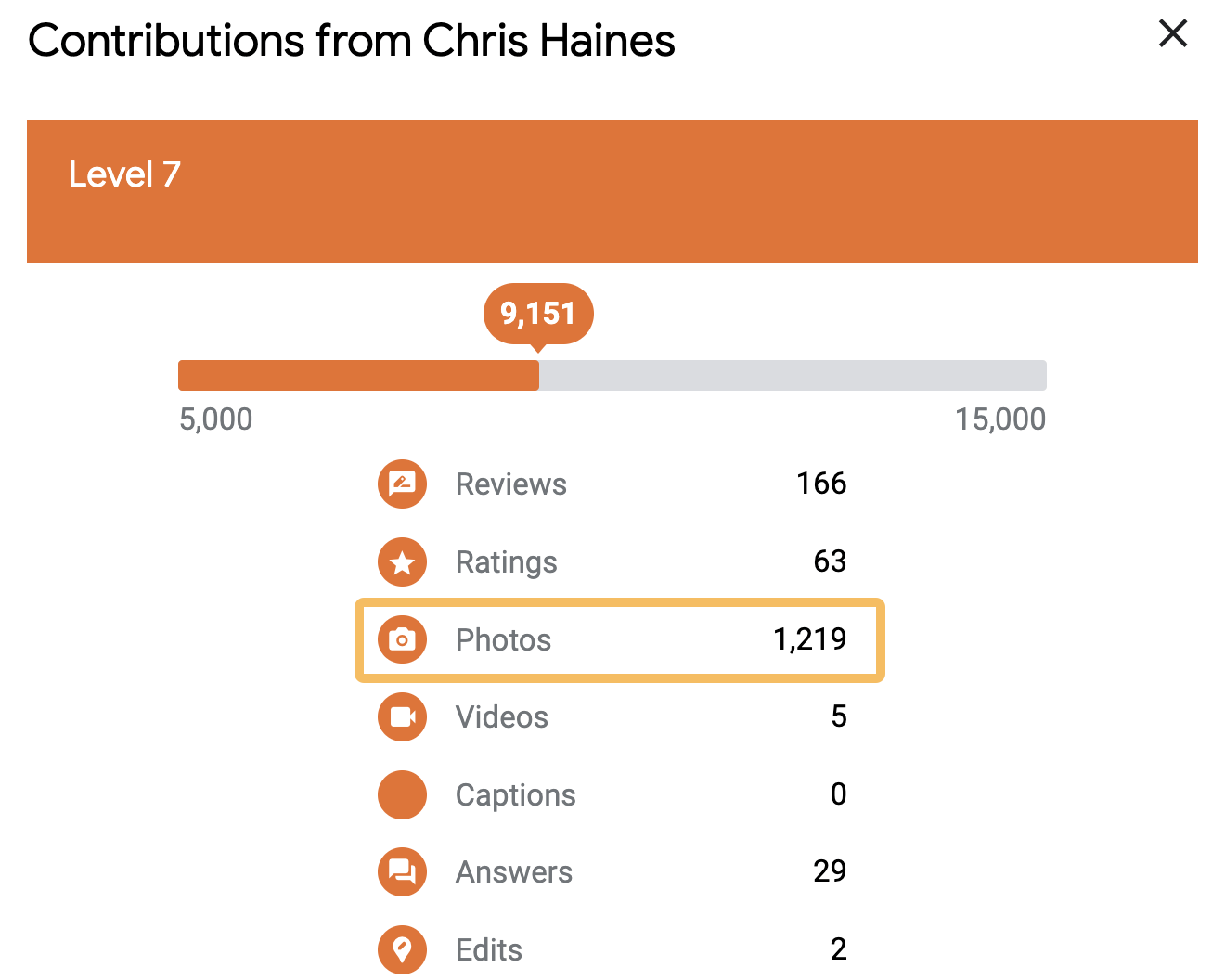

One of the photos I uploaded was a half-eaten Subway. It still amazes me that 50,974 people have seen this photo:
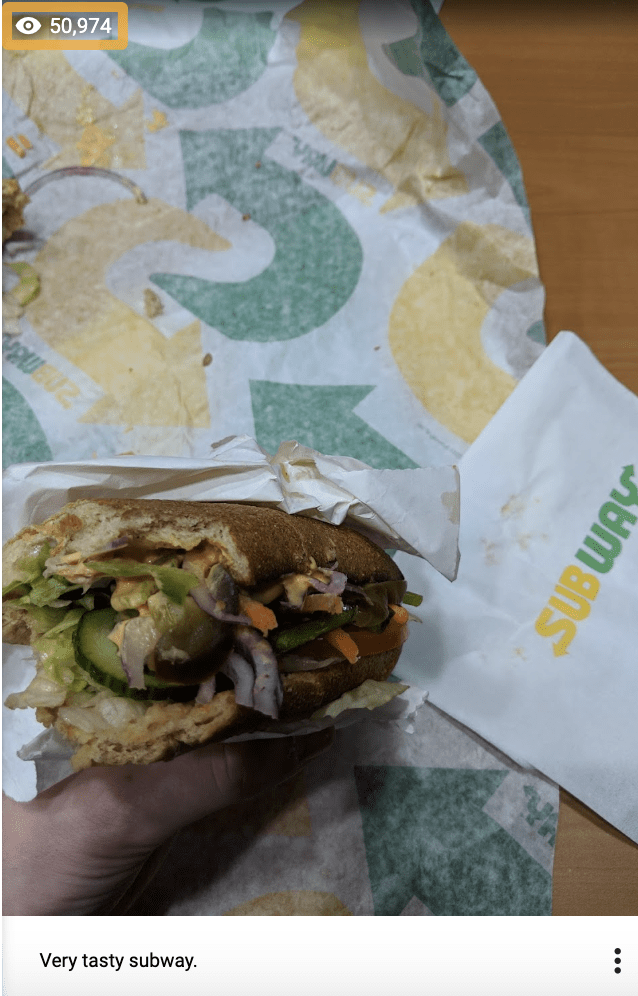

This wasn’t exactly SEO, but the ability to find this ‘hack’ so quickly impressed him, and we struck up a friendship.
The next month that person moved to another company, and then another few months later, he offered me an SEO Lead job.
Tip
Build connections with everyone you can—you never know who you might need to call on next.
Final thoughts
The road to becoming an SEO Lead seems straightforward enough when you start out, but it can quickly become long and winding.
But now armed with my tips, and a bucket load of determination, you should be able to navigate your way to an SEO Lead role much quicker than you think.
Lastly, if you want any more guidance, you can always ping me on LinkedIn. 🙂
SEO
7 Content Marketing Conferences to Attend in 2024

I spend most of my days sitting in front of a screen, buried in a Google Doc. (You probably do too.)
And while I enjoy deep work, a few times a year I get the urge to leave my desk and go socialize with other human beings—ideally on my employer’s dime 😉
Conferences are a great excuse to hang out with other content marketers, talk shop, learn some new tricks, and pretend that we’re all really excited about generative AI.
Without further ado, here are the biggest and best content marketing conferences happening throughout the rest of 2024.
Dates: May 5–7
Prices: from $795
Website: https://cex.events/
Location: Cleveland, OH
Speakers: B.J. Novak, Ann Handley, Alexis Grant, Justin Welsh, Mike King
CEX is designed with content entrepreneurs in mind (“contenpreneurs”? Did I just coin an awesome new word?)—people that care as much about the business of content as they do the craft.
In addition to veteran content marketers like Ann Handley and Joe Pulizi waxing lyrical about modern content strategy, you’ll find people like Justin Welsh and Alexis Grant exploring the practicalities of quitting your job and becoming a full-time content creator.
Here’s a trailer for last year’s event:
Sessions include titles like:
- Unlocking the Power of Book Publishing: From Content to Revenue
- Quitting A $200k Corporate Job to Become A Solo Content Entrepreneur
- Why You Should Prioritize Long-Form Content
(And yes—Ryan from The Office is giving the keynote.)
Dates: Jun 3–4
Location: Seattle, WA
Speakers: Wil Reyolds, Bernard Huang, Britney Muller, Lily Ray
Prices: from $1,699
Website: https://moz.com/mozcon
Software company Moz is best known in the SEO industry, but its conference is popular with marketers of all stripes. Amidst a lineup of 25 speakers there are plenty of content marketers speaking, like Andy Crestodina, Ross Simmonds, and Chima Mmeje.
Check out this teaser from last year’s event:
This year’s talks include topics like:
- Trust and Quality in the New Era of Content Discovery
- The Power of Emotion: How To Create Content That (Actually) Converts
- “E” for Engaging: Why The Future of SEO Content Needs To Be Engaging
Dates: Sep 18–20
Location: Boston, MA
Speakers: TBC
Prices: from $1,199
Website: https://www.inbound.com/
Hosted by content marketing OG HubSpot, INBOUND offers hundreds of talks, deep dives, fireside chats, and meetups on topics ranging from brand strategy to AI.
Here’s the recap video:
I’ve attended my fair share of INBOUNDs over the years (and even had a beer with co-founder Dharmesh Shah), and always enjoy the sheer choice of events on offer.
Keynotes are a highlight, and this year’s headline speaker has a tough act to follow: Barack Obama closed out the conference last year.
Dates: Oct 22–23
Location: San Diego, CA
Speakers: TBC
Prices: from $1,199
Website: https://www.contentmarketingworld.com/
Arguably the content marketing conference, Content Marketing World has been pumping out content talks and inspiration for fourteen years solid.
Here’s last year’s recap:
The 2024 agenda is in the works, but last year’s conference explored every conceivable aspect of content marketing, from B2C brand building through to the quirks of content for government organizations, with session titles like:
- Government Masterclass: A Content Marketing Strategy to Build Public Trust
- A Beloved Brand: Evolving Zillow’s Creative Content Strategy
- Evidence-Based SEO Strategies: Busting “SEO Best Practices” and Other Marketing Myths
Dates: Oct 24–25
Location: Singapore
Speakers: Andy Chadwick, Nik Ranger, Charlotte Ang, Marcus Ho, Victor Karpenko, Amanda King, James Norquay, Sam Oh, Patrick Stox, Tim Soulo (and me!)
Prices: TBC
Website: https://ahrefs.com/events/evolve2024-singapore
That’s right—Ahrefs is hosting a conference! Join 500 digital marketers for a 2-day gathering in Singapore.
We have 20 top speakers from around the world, expert-led workshops on everything from technical SEO to content strategy, and tons of opportunities to rub shoulders with content pros, big brands, and the entire Ahrefs crew.
I visited Singapore for the first time last year and it is really worth the trip—I recommend visiting the Supertree Grove, eating at the hawker markets in Chinatown, and hitting the beach at Sentosa.
If you need persuading, here’s SEO pro JH Scherck on the Ahrefs podcast making the case for conference travel:
And to top things off, here’s a quick walkthrough of the conference venue:
Dates: Oct 27–30
Location: Portland, OR
Speakers: Relly Annett-Baker, Fawn Damitio, Scott Abel, Jennifer Lee
Prices: from $1,850
Website: https://lavacon.org/
LavaCon is a content conference with a very technical focus, with over 70 sessions dedicated to helping companies solve “content-related business problems, increase revenue, and decrease production costs”.
In practice, that means speakers from NIKE, Google, Meta, Cisco, and Verizon, and topics like:
- Operationalizing Generative AI,
- Taxonomies in the Age of AI: Are they still Relevant?, and
- Out of Many, One: Building a Semantic Layer to Tear Down Silos
Here’s the recap video for last year’s conference:
Dates: Nov 8
Location: London
Speakers: Nick Parker, Tasmin Lofthouse, Dan Nelken, Taja Myer
Prices: from £454.80
Website: https://www.copywritingconference.com/
CopyCon is a single-day conference in London, hosted by ProCopywriters (a membership community for copywriters—I was a member once, many years ago).
Intended for copywriters, creatives, and content strategists, the agenda focuses heavily on the qualitative aspects of content that often go overlooked—creative processes, tone of voice, and creating emotional connections through copy.
It’s a few years old, but this teaser video shares a sense of the topics on offer:
This year’s talks include sessions like:
- The Mind-Blowing Magic of Tone of Voice,
- The Power of AI Tools as a Content Designer, and the beautifully titled
- Your Inner Critic is a Ding-Dong.
(Because yes, your inner critic really is a ding-dong.)
Final thoughts
These are all content-specific conferences, but there are a ton of content-adjacent events happening throughout the year. Honourable mentions go to DigiMarCon UK 2024 (Aug 29–30, London, UK), Web Summit (Nov 11–14, Lisbon, Portugal), and B2B Forum (Nov 12–14, Boston, MA).
I’ve focused this list solely on in-person events, but there are also online-only conferences available, like ContentTECH Summit (May 15–16).
Heading to a content conference that I haven’t covered? Share your recommendation with me on LinkedIn or X.
-

 PPC4 days ago
PPC4 days ago19 Best SEO Tools in 2024 (For Every Use Case)
-

 PPC7 days ago
PPC7 days ago4 New Google Ads Performance Max Updates: What You Need to Know
-
SEARCHENGINES6 days ago
Daily Search Forum Recap: April 16, 2024
-

 MARKETING6 days ago
MARKETING6 days agoWill Google Buy HubSpot? | Content Marketing Institute
-

 SEO6 days ago
SEO6 days agoGoogle Clarifies Vacation Rental Structured Data
-
SEARCHENGINES5 days ago
Daily Search Forum Recap: April 17, 2024
-

 MARKETING6 days ago
MARKETING6 days agoStreamlining Processes for Increased Efficiency and Results
-

 PPC7 days ago
PPC7 days agoHow to Collect & Use Customer Data the Right (& Ethical) Way















